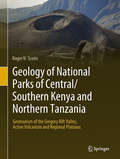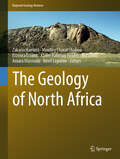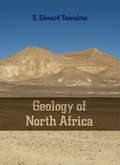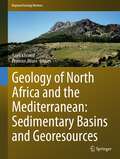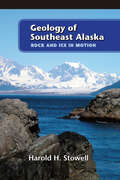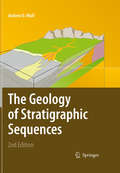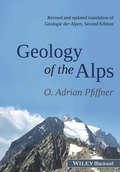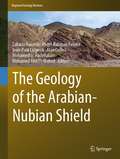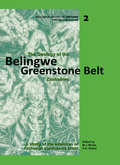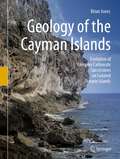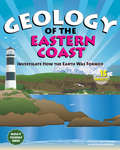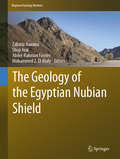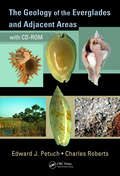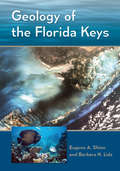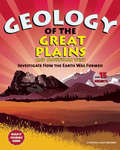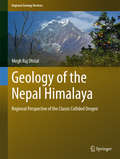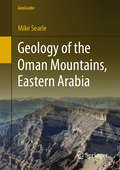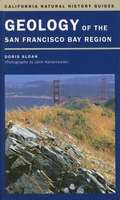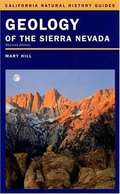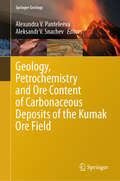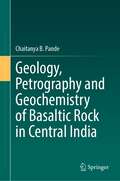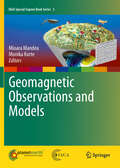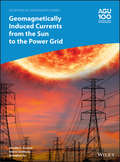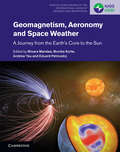- Table View
- List View
Geology of National Parks of Central/Southern Kenya and Northern Tanzania: Geotourism Of The Gregory Rift Valley, Active Volcanism And Regional Plateaus
by Roger N. ScoonThis book describes the interrelationship between the spectacular geology of an area of East Africa that includes a branch of the rift valley, as well as giant freestanding ice-capped mountains and extraordinarily toxic, alkaline lakes, and some of the greatest concentrations of wildlife on Earth. It suggests that geological processes that have shaped the iconic landforms, including active volcanoes, may also be responsible for the unusually diverse speciation which characterises the region. Moreover, it is not a coincidence that important palaeoanthropological discoveries have been unearthed in the region. National parks and conservation areas have tremendous potential for geotourism and the book assists both tour guides and visitors in this regard. In addition, the book may provide a better understanding to management of the importance of geology for sustaining wildlife.
Geology of National Parks (Sixth Edition)
by Ann G. Harris Esther Tuttle Sherwood D. TuttleHighlights the local history as well as the geologic features and developments of national parks formed by stream erosion and weathering, glaciers and wave action, igneous activity, mountain building and uplift, and ground water.
The Geology of North Africa (Regional Geology Reviews)
by Ezzoura Errami Zakaria Hamimi Abdel-Rahman Fowler Moulley Charaf Chabou Nuri Fello Amara Masrouhi Rémi LeprêtreThis richly illustrated book reviews the geology, tectonics, sedimentary basins and strategic resources of North Africa in 21 chapters. Chapter 1 is a regional synthesis. Chapter 2 examines the deep crustal and upper mantle structure. Chapter 3 compares the West African Craton. Chapters 4,5,6,7 deal with Pan-African-, Variscan (Hercynian)- and Alpine-Belts. Precambrian Geology of Hoggar Shield, north Central Africa will be addressed in Chapter 8. The North African Neoproterozoic and Phanerozoic sedimentary basins are the topic of Chapter 9. Phanerozoic magmatism and geodynamic framework of North Africa are addressed in Chapter 10. Chapters 11,12 deal with petroleum geology and water resources. Important non-metallic- and metallic- ore deposits are presented in Chapter 13,14,15,16. Chapters 17,18 explore geothermal energy and other strategic resources. Chapters 19,20 discuss seismicity, seismotectonics and Neotectonics, and Advances of exploration geophysics in North Africa. The lasttwo chapters (20, 21) focus on meteoric impact craters, geoheritage, geoparks and geotourism in North Africa.
Geology of North Africa
by Edward TawadrosA reference volume on the geology of North Africa, this volume deals with Egypt, Libya, Algeria, Tunisia and Morocco. In great detail the geology, tectonic elements, the geology of the Pan-African Shield, the Phanerozoic geological evolution and most of the lithostratigrahpic units of the five countries are described. Moreover, the petroleum geolog
Geology of North Africa and the Mediterranean: Sedimentary Basins and Georesources (Regional Geology Reviews)
by Sami Khomsi Francois RoureThis book summarizes the links between the evolution of sedimentary basins of Northern Africa and Peri-Mediterranean in different tectonic settings and the distribution of georesources in those basins. Georesources include fossil energy, geothermal energy, deep aquifers, minerals and deposits. This book also provides key information for energy resources in these important areas. The book is in part a compilation of selected papers from Atlas Georesources International Congress, Hammamet, Tunisia, (AGIC 2017) which were extended after the congress in addition to other contributions from geoscientists based at some universities and companies from the region. It is organized in a set of research studies focusing on the architecture, geodynamic evolution and modeling of sedimentary basins in the Middle East, North Africa and the Mediterranean domain. Future developments in the exploration for water, energy and other georesources are very important in these regions. In this context, this book constitutes an important reference for a wide range of geoscientists and companies as it defines the distribution and potentialities of these resources.
Geology of Southeast Alaska: Rock and Ice in Motion
by Harold StowellThe most powerful forces on earth have shaped the landscape of Southeast Alaska. Scientists and visitors from around the world trek north to experience wild rivers, powerful glaciers, and breathtaking mountain peaks. Now, for the first time, a handy guide to the region is available. Complete with color illustrations revealing millions of years of geological history and in-depth descriptions of Sitka, Juneau, and Glacier Bay, Geology of Southeast Alaska is essential reading for anyone fascinated by rock and ice in motion. Written by a geologist with over twenty-five years of experience in the north, Geology of Southeast Alaska will entertain and inform with abundant photographs and detailed drawings. Whether you want to understand the forces that shaped the state of Alaska, or you want to learn the basics of glacial movement, this compact, authoritative book is for you.
The Geology of Stratigraphic Sequences
by Andrew D. MiallIt has been more than a decade since the appearance of the First Edition of this book. Much progress has been made, but some controversies remain. The original ideas of Sloss and of Vail (building on the early work of Blackwelder, Grabau, Ulrich, Levorsen and others) that the stratigraphic record could be subdivided into sequences, and that these sequences store essential information about basin-forming and subsidence processes, remains as powerful an idea as when it was first formulated. The definition and mapping of sequences has become a standard part of the basin analysis process. The main purpose of this book remains the same as it was for the first edition, that is, to situate sequences within the broader context of geological processes, and to answer the question: why do sequences form? Geoscientists might thereby be better equipped to extract the maximum information from the record of sequences in a given basin or region. Tectonic, climatic and other mechanisms are the generating mechanisms for sequences ranging over a wide range of times scales, from hundreds of millions of years to the high-frequency sequences formed by cyclic processes lasting a few tens of thousands of years
Geology of the Alps
by O. Adrian PfiffnerThe Alps, with their outstanding outcrop conditions, represent a superb natural laboratory for many geological processes, and have played a crucial role in the history of geology. This book gives an up-to-date and holistic overview of the key aspects of Alpine geology. After a brief presentation of the plate tectonic framework, the rock suites are discussed, starting with the pre-Triassic crystalline basement, followed by Paleozoic, Mesozoic and Cenozoic sedimentary sequences. The lithological description of the rock types is supplemented by a discussion of their paleogeographic and plate tectonic contexts. The book goes on to describe the structure of the Alps (including the Jura Mountains and the Alpine foreland to the north and south) illustrated by numerous cross-sections. The evolution of the Alps as a mountain chain incorporates a discussion of the Alpine metamorphic history and a compilation of orogenic timetables. The final sections cover the evolution of Alpine drainage patterns and the region’s glacial history. Readership: The book is essential reading for students and lecturers on Alpine courses and excursions, and all earth-scientists interested in the geology of the region.
The Geology of the Arabian-Nubian Shield (Regional Geology Reviews)
by Zakaria Hamimi Abdel-Rahman Fowler Jean-Paul Liégeois Alan Collins Mohamed G. Abdelsalam Mohamed Abd EI-WahedThis richly illustrated book reviews the geology, tectonics and mineralization of the Arabian-Nubian Shield (ANS) in 27 chapters. It starts with an examination of the ANS lithospheric scale features, explores Mesoproterozoic units and deals with the ANS oceanic stage. Arc volcanism and plutonism, post-collision basins and volcanics are discussed, as well as the younger granitoid magmatism and the deformation history of the ANS. The book provides information on ANS glacial stages and late magmatism. Chapters are devoted to review the transition between ANS and the reworked continent to its south. Finally, it discusses how ANS structures influenced the overall East African Rift System.
The Geology of the Belingwe Greenstone Belt, Zimbabwe: A study of Archaean continental crust
by M.J. Bickle A. Martin E.G. Nisbet J.L. OrpenA study on the Bellingwe Greenstone Belt, presenting the stratigraphy of the belt, its structure and tectonic setting, the sedimentology of what may be a rift basin, the geochemistry of the freshest Archaean komatiites yet found, and models of the evolution of the region.
Geology of the Cayman Islands: Evolution of Complex Carbonate Successions on Isolated Oceanic Islands
by Brian JonesGrand Cayman, Little Cayman, and Cayman Brac are, in reality, the summits of independent fault blocks that rise from the depths of the Caribbean Sea. This book traces the geological evolution of these islands over the last 30 to 35 million years. The balance between deposition of carbonate sediments and karst development of the exposed land was dictated by the interaction between ever-changing sea levels and vertical tectonic movement of the fault blocks. Today, drinking water needed for the ever-increasing populations of the islands is supplied largely by desalinization plants that are located in accord with a detailed knowledge of the bedrock.This book is based on an extensive data base that has been assembled over the last 40 years of field work and laboratory analyses. Noteworthy aspects of this database include:Approximately 60 visits to the islands over last 40 years – sampling and documentation of virtually every accessible outcrop on the islands (including some that no longer exist). Most samples have been fully documented petrographically and geochemically.Data from 120 wells that have been drilled to depths up to 245 m (most less than 125 m). Wells have been cored and/or chip sampled. Full documentation of drilling histories, XRD analyses of samples, extensive geochemical analyses for major and minor elements, stable isotopes, 87Sr/86Sr ratios, and Rare Earth Elements from numerous samples.Mapping and sampling of modern sediments, including sediment cores, from most of the lagoons around Grand Cayman.Extensive thin section petrography, scanning electron microscope, and electron microprobe analyses of the dolostones and limestones that form the bedrock of the islands.Samples and data collected from numerous caves on Grand Cayman and Cayman Brac have been used to track their developmental history.Detailed analyses of phosphates collected from Little Cayman.Detailed analyses of terra rossa collected from each of the islands.
Geology of the Eastern Coast
by Cynthia Light BrownTaking a unique approach to a fascinating region of the United States, this activity guide looks at the underlying processes that have shaped the Eastern Coast. Beginning with the connection between geology and geography, the chapters move into a discussion of plate tectonics and landforms such as the Appalachian Mountains, Piedmont area, and Coastal Plains. The aspects of climate, rivers and lakes, and the ecosystems of the temperate forest and wetlands--including bayous and the Everglades--are covered in detail. Engaging sidebars explain why the New River is one of the oldest in the world, how once-endangered alligators are now thriving, how hurricanes form, and more. Combining fun facts with hands-on experiments, this handbook features projects such as building folded mountains, creating dissolving "corals," and making an eye of a storm.
The Geology of the Egyptian Nubian Shield (Regional Geology Reviews)
by Zakaria Hamimi Shoji Arai Abdel-Rahman Fowler Mohammed Z. El-BialyThis richly illustrated book provides an overview of the Neoproterozoic Pan-African Belt of Egypt (PABE), which represents the northwestern continuation of the Arabian-Nubian Shield (ANS) and the East African Orogen (EAO). The first chapter offers an introduction to the Turin Papyrus Map and the historical background of the PABE, while the second addresses how the PABE is related to the ANS and EAO. Rock succession of the PABE is dealt with in Chapter 3, while Chapter 4 focuses on Sinai Metamorphic Core Complexes and implications on the break-up of Rodinia. Subsequent chapters discuss a broad range of topics, e.g. ophiolite-dominated suprastructural rocks; volcanosedimentary succession, Neoproterozoic volcanism and volcanic rocks in Egypt; enigmatic issues concerning granite, Dokhan and Hammamat sediments; the lithospheric mantle beneath the Northeast African continent and the mantle section of Neoproterozoic ophiolites from the PABE; sutures, megashears and petrogenetic evolution of the Neoproterozoic rocks of Egypt; and metallic and non-metallic mineral deposits in the PABE, which are covered in extensive detail. The book’s closing chapters discuss the application of remote sensing techniques and anisotropy of magnetic susceptibility (AMS) to decipher the tectonic evolution of the PABE, as well as the use of geophysical data to map structural features and hydrothermal alteration zones in the PABE.
The Geology of the Everglades and Adjacent Areas
by Edward J. Petuch Charles RobertsPainting a complete picture of the history of the Everglades, The Geology of the Everglades and Adjacent Areas brings together theperspectives of various geoscientists to provides an overview of the geology, paleontology, and paleoceanography of the Everglades region. It emphasizes the upper 300 m of the geologic framework of the area and gives insight into the local stratigraphy, geomorphology, lithology, and historical geology. Building upon the geologic nomenclature and stratigraphic sequences set down by the Florida Geological Survey, the book includes redefinitions of some previously poorly known formations, the chronological fine-tuning of other poorly known units, and the description of 7 new members.Designed to be a field guide as well as a reference, the book is illustrated with photographs of exposed geologic sections, stratotype localities, collection sites, and details of interesting fossil beds. It contains 124 full-page illustrations with 69 black and white figures, 43 black and white plates of index fossils, and 12 full color plates of simulated space shuttle images of Florida’s ancient seas and coastlines. This text is accompanied by downloadable resources that feature animated maps along with a Power Point presentation of simulated space shuttle imagery of Eocene-to-Holocene Florida. The book is arranged by geologic time, ranging from the late Eocene, Oligocene, Miocene, Pliocene, and Pleistocene to the Holocene. The authors place lithostratigraphic descriptions of the geologic formations and members into this chronological framework, along with the paleogeography of the seas and lakes within which they were deposited. They also emphasize biostratigraphy with over 1000 index fossils listed and over 400 illustrated. The book brings together information previously spread through innumerable publications, saving you the time and effort it would take to assemble and cross-reference multiple sources.
Geology of the Florida Keys
by Eugene A. Shinn Barbara H. Lidz"A joy to read from two of the most prominent geologists who have worked for the better part of their careers in the Florida Keys. Places important environmental focus on modern-day issues facing the island ecosystems, the health of Florida Bay, the nearshore areas, and ultimately the reef tract."--Donald F. McNeill, University of Miami "A compelling narrative that weaves fascinating historical personalities and periods with the geological characteristics of the Florida Keys into a colorful tapestry. A fun, interesting, and informative read!"--Eugene C. Rankey, University of Kansas Two world-class geologists draw on their prolific fifty-year careers in this comprehensive guide to the geology and biology of the Florida Keys and Florida Bay. Eugene Shinn and Barbara Lidz dive into the past, present, and future of an area that has long been a natural laboratory for learning about coral reef formation and the origins of limestone. They explain how underlying Pleistocene topography controls the shapes of today's coral reefs, how sea-level rise created Florida Bay, and how hurricanes mold limemud banks and strip vegetation from the Florida Keys. They discuss the recent decline of coral reefs due to overpopulation, pollution, climate change, and other factors. An itinerary is included for a hands-on three-day field trip, guiding visitors to the best places to see the famous reef formations and geologic processes of the Keys. As glaciers continue to melt and reform at Earth's poles, sea level is currently rising and will fall again at some point in the geologic future. In this volume, Shinn and Lidz demonstrate the value of the Keys and immediate surroundings as an environmental laboratory to study past effects of sea-level change and to stimulate ideas for further research.
Geology of the Great Plains and Mountain West
by Cynthia Light BrownAnswering intriguing questions such as Why does the largest river system in North America meander across the middle of the continent? and How does such a system relate to the rugged Rocky Mountains?, this fun-filled book delves into the majestic Great Plains region. The chapters concisely clarify the interrelated subjects of terrain, climate, and the great movements of the earth itself while illustrating the important changes that are still occurring in the area's rivers, lakes, plains, and unpredictable weather. Brimming with fascinating facts, educational sidebars tell how earthquakes in New Madrid, Missouri caused waves to go upstream in the Mississippi River; why and how tornadoes form; and how invasive species are threatening the Great Lakes and what people are doing about it.
Geology of the Nepal Himalaya: Regional Perspective Of The Classic Collided Orogen (Regional Geology Reviews Ser.)
by Megh Raj DhitalThis book addresses the geology of the entire Himalayan range in Nepal, i. e. , from the Gangetic plain in the south to the Tethyan zone in the north. Without a comprehensive look at the various Himalayan zones, it is practically impossible to fully grasp the processes at work behind the formation and development of the spectacular Himalaya. However, the goal is not merely to document all the scientific ontology but rather to reveal a sound basis for the prevailing concepts. Both the early literature on Himalayan geology and contemporary trends are fully covered. For the first time, the origin, use, and abuse of common Himalayan geological terms such as the Siwaliks, Lesser Himalaya, Main Boundary Thrust, Main Central Thrust, and Tethys are discussed. The book will help readers to progress from a cognitive approach to a constructive one by linking various types of knowledge, such as seeking relations between various geological structures as well as between earlier thoughts or views and contemporary approaches.
Geology of the Oman Mountains, Eastern Arabia (GeoGuide)
by Mike SearleThis book describes in detail numerous geological sites throughout the mountains of Oman and the United Arab Emirates (UAE) in Eastern Arabia. The region is well known for its oil and gas reserves in the desert interior, and Permian-Mesozoic shelf carbonates exposed in the mountains of the Musandam peninsula, Jebel al-Akhdar and Saih Hatat, where deep wadi canyons provide impressive three-dimensional views into the crust. The region has numerous globally important geological sites, including the world’s largest and best-exposed ophiolite complex, the Semail Ophiolite, which is a vast thrust sheet of Cretaceous ocean crust and upper mantle emplaced onto the Arabian continental margin. Other sites include spectacular fossil localities, subduction zone metamorphic rocks (eclogites, blueschists, amphibolites), fold-thrust belts, giant sheath folds and Precambrian salt domes, as well as the huge sand dunes of the Rub al’Khali, the Empty Quarter, and the separate Wahiba (Sharkiyah) sandsea of Eastern Oman.Written by Mike Searle, who has worked on geological research projects throughout Oman and UAE almost every year since 1978, this book describes the field geology of each site and includes a wealth of maps, field photos and diagrams illustrating key features. It also discusses the history of exploration of Arabia and the search for its hidden geological secrets. The book provides the geological basis for the establishment of a series of World Heritage Sites, National GeoParks and Sites of Special Scientific Interest (SSSI) throughout the region. As such, it is of interest to geologists, tourists, mountaineers, trekkers, rock climbers and naturalists.
Geology of the San Francisco Bay Region (California Natural History Guides)
by Doris SloanThis book is for San Francisco Bay Area residents and visitors who want to explore the geologic world of this spectacular area, to learn about its shapes, colors, and rocky foundations. Doris Sloan illuminates the colorful geologic mosaic that surrounds San Francisco Bay and lucidly explains the complex and fascinating processes that have forged it over millions of years.
Geology of the Sierra Nevada (Revised Edition)
by Mary HillThe author introduces the rocks of the Sierra Nevada, which tell the mountains' tale, and explains how nature's forces, such as volcanic eruptions, earthquakes, faulting, erosion, and glaciation formed the range's world-renowned scenery and mineral wealth, including gold.
Geology, Petrochemistry and Ore Content of Carbonaceous Deposits of the Kumak Ore Field (Springer Geology)
by Alexandra V. Panteleeva Aleksandr V. SnachevThe main prospects for expanding the mineral resource base of gold are associated with the discovery of typical ore objects within the distribution of productive black shale strata in the Orenburg part of the Southern Urals. The solution of this problem is significantly associated with the discovery, evaluation and involvement in the industrial development of gold deposits lying in the black shale strata. Their practical significance, based on existing concepts, can be considered in several aspects: first of all, it is a possible source of metals, and secondly, they are a reducing geochemical barrier for the deposition of ore matter of deep fluids. The formations of the black shale formation are a favorable geochemical environment for the primary concentration of gold, platinum group elements, tungsten, molybdenum and other metals. Areas of manifestation of tectonic activity, zonal and contact metamorphism, and the dyke complex are of great importance. Moreover, carbonaceous deposits are a very informative material for the reconstruction of paleogeographic and physico-chemical conditions of their accumulation. In this regard, the ore-containing black shales of the Kumak deposit, whose rocks have a specialization in gold, seem to be a very attractive object for a comprehensive study of ore content. They may be of great practical importance for the search for new deposits in the Southern Urals and in other regions with a similar geological structure.
Geology, Petrography and Geochemistry of Basaltic Rock in Central India
by Chaitanya B. PandeThis book examines novel geological formations and lava flows of basaltic rock in India, and provides a comprehensive understanding of basaltic rock geology, petrography, stratigraphy and geochemistry. Readers are given insight into the geologic conditions of basaltic rock in central India, and a basic introduction to field geology methods and parameters in the study region. The author shows detailed petrographic and mineralogical characteristics of various basaltic rock formations, and identifies key features using major, trace and rare earth element stratigraphic analysis. An analysis of the sequence of hydro-geological formations of the basaltic rock area using ground water fluctuation models is also provided to assess surface and groundwater resources, which are important for planning development in the basaltic hard rock area. The book aims to be a resource for researchers, scientists, teachers and students interested in geology, petrography and geochemistry.
Geomagnetic Observations and Models
by M. Mandea Monika KorteThis volume provides comprehensive and authoritative coverage of all the main areas linked to geomagnetic field observation, from instrumentation to methodology, on ground or near-Earth. Efforts are also focused on a 21st century e-Science approach to open access to all geomagnetic data, but also to the data preservation, data discovery, data rescue, and capacity building. Finally, modeling magnetic fields with different internal origins, with their variation in space and time, is an attempt to draw together into one place the traditional work in producing models as IGRF or describing the magnetic anomalies.
Geomagnetically Induced Currents from the Sun to the Power Grid (Geophysical Monograph Series #246)
by Jennifer L. Gannon Andrei Swidinsky Zhonghua XuAn introduction to geomagnetic storms and the hazards they pose at the Earth’s surface Geomagnetic storms are a type of space weather event that can create Geomagnetically Induced Currents (GICs) which, once they reach Earth’s surface, can interfere with power grids and transport infrastructure. Understanding the characteristics and impacts of GICs requires scientific insights from solar physics, magnetospheric physics, aeronomy, and ionospheric physics, as well as geophysics and power engineering. Geomagnetically Induced Currents from the Sun to the Power Grid is a practical introduction for researchers and practitioners that provides tools and techniques from across these disciplines. Volume highlights include: Analysis of causes of geomagnetic storms that create GICs Data and methods used to analyze and forecast GIC hazard GIC impacts on the infrastructure of the bulk power system Analysis techniques used in different areas of GIC research New methods to validate and predict GICs in transmission systems
Geomagnetism, Aeronomy and Space Weather: A Journey from the Earth's Core to the Sun (Special Publications of the International Union of Geodesy and Geophysics #4)
by Mioara Mandea Monika Korte Andrew Yau Eduard PetrovskýOn the centenary of the International Union of Geodesy and Geophysics, this book reviews the state-of-the-art research in geomagnetism, aeronomy and space weather. Written by eminent researchers from these fields, it summarises the advances in research over the past 100 years, and looks ahead to current and emerging studies on Earth's magnetic field. It provides a comprehensive overview of the generation of Earth's magnetic field, its history and its response to external forces. Starting at the centre of the Earth, the reader is taken on a journey from the interior core and mantle, through the upper atmosphere and magnetosphere, before reaching the Sun's atmosphere and corona. The applications of this research are also discussed, particularly the societal impact of solar activity on critical infrastructures in our increasingly technologically dependant society. This book provides a valuable resource and reference to academic researchers and students in geomagnetism and aeronomy.
